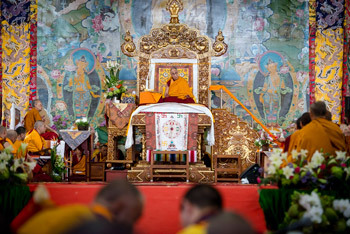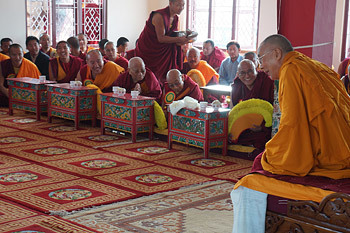Bylakuppe, Karnataka, India, 31 December 2013 - For the past week His Holiness the Dalai Lama has been staying at Sera Mey, but teaching every day at Sera Jey. Every day he’s made a short drive between the two colleges. This morning he drove out of Sera Mey in the opposite direction and out onto a plain earth track that brought him to the new Sera Mey Retreat Centre. He had been invited to inaugurate the facility, which consists of a small, simple temple and a collection of retreat houses. He cut the ribbon on the temple door, opened it, entered and paid his respects before taking his seat. He said:
“I appreciate what you’re doing here. One of the Sera Mey disciplinarians asked me if Sera Mey could introduce a period of silent meditation during the morning prayers every day. I recalled that Phabongka Rinpoche had a custom of keeping a period of silence at the point in the sadhana where you take the three bodies into the path, so there is a precedent. It’s good if you do that, and this retreat centre is a good extension of your activities too. Until now the Three Seats - Ganden, Drepung and Sera - have provided excellent facilities for study and it’s good that you are augmenting them with these meditation facilities too.”
From the retreat centre His Holiness drove to Serjey Khensur Lo Thupten’s residence to visit the Khensur who is an old friend, but too indisposed to come to see him. It was a short distance from there to the teaching ground.
“Everything good we experience in the world, from our daily needs to our spiritual practices is due to the kindness of other beings,” he began. “The all-knowing Gendun Drub, the first Dalai Lama said that as a result we should feel grateful to all other sentient beings. When one of his disciples remarked that as a result of his positive activities Gendun Drub, who was a student of Je Tsongkhapa, would probably be born in Sukhavati, Amitabha’s pure land. He replied that he had no wish to be born in Sukhavati; he wanted to return among other sentient beings. The 1st Dalai Lama founded Tashi Lhunpo monastery, while the second, Gendun Gyatso founded Chokorgyel Monastery on the edge of Lhamo Latso lake. The 3rd Dalai Lama, Sonam Gyatso, spent a significant amount of his life in Mongolia.”
His Holiness recounted that when he left Norbulingka, he brought with him a copy of the Great Stages of Path, some shirts, divination dice that had belonged to the 13th Dalai Lama and some other things that had belonged to the 2nd. About 5000 monks from different monasteries escaped from Tibet around the same time. His Holiness said that he requested that 1500 be accommodated together in order that they could continue their studies and practice. The Government of India offered to look after 300, but he continued to ask for 1500 and eventually they were housed at Buxa. However, because of food and climate being vastly different to what they were used to many died. This is why at the earliest opportunity they were moved to the emerging settlements here in South India. To begin with they lived in very poor conditions, but gradually things improved.
“

|
His Holiness the Dalai Lama speaking during the seventh day of his teachings at Sera Jey Monastery in Bylakuppe, Karnataka, India on December 31, 2013. Photo/Tenzin Choejor/OHHDL
|
We are following the pure Nalanda tradition. Such opportunities are not easy to find, so we are taking advantage of them and trying to make life meaningful by engaging in the practice of the three trainings. If, however, you use your Buddhist studies as the basis for earning money, you’ll be reinforcing your self-centredness and misconceptions about true existence. And that would be sad.”
His Holiness took up his reading from the ‘Swift Path’ and spent a moment explaining that he had been late because he’d been to the Sera Mey retreat centre and gone on to visit Serjey Khensur Lo Thupten, who, since he was also a student of Trijang Rinpoche and Ling Rinpoche, he considers like a spiritual brother. But he said during those meetings he did not forget that thousands of people were waiting for him at the teaching ground. As he read through the sections about the practice of a great being, he noted that although we want happiness, we create the causes for suffering. Thinking of liberating all sentient beings from suffering and leading them to omniscience, free of the two defilements, you have to ask yourself, “Do I have the capacity to do that?”
The next section of the text dealt with the practice of equalising and exchanging self with others, which the ‘Guide to the Bodhisattva’s Way of Life’ refers to as practising the secret. It is based on the idea that the welfare of others is more important than your own. Je Rinpoche says of this that when you help other sentient beings, you also fulfil your own benefit.
“When you have acquired wisdom and understood what to discard and what to adopt, you’ll be able to do the practice effectively. Helping others through morality, patience and effort you also fulfil your own interest.”
With regard to the custom of vegetarianism, there is no prohibition about eating meat in the Vinaya. A Sri Lankan monk told His Holiness that this is because monks who follow the alms round cannot choose what they will eat, they have to accept whatever they are offered whether it is vegetarian or not. He explained that during the 1960s he became a vegetarian for many months until he developed jaundice and, as he often jokes, became temporarily like a yellow-golden ‘Living Buddha’. At this point his doctors advised him for his health to resume his previous diet. Now he eats meat only 2 or 3 time a week. Meanwhile, the monks in the monasteries here in the South have adopted vegetarianism, which is very good. It has been suggested that Atisha was vegetarian.
|
Some of the interpreters translating His Holiness the Dalai Lama's teachings into 10 different languages at Sera Jey Monastery in Bylakuppe, Karnataka, India on December 31, 2013. Photo/Jeremy Russell/OHHDL
|
Opening the afternoon session, His Holiness talked about the 5th Dalai Lama, author of the ‘Sacred Words of Manjushri’ that he is reading.
“The Great Fifth was a simple monk. Trijang Rinpoche had a handwritten copy of his biography, which revealed a simple monk not proud or puffed up, despite being King of Tibet. An example describes the Fifth quietly in his room while his attendants basked in the sun outside and how he often had to call two or three times to get their attention. The 13th Dalai Lama was similar. He was strict about the use of snuff, which he prohibited. However, once when construction of one of the palaces at Norbulingka was going on, he came to inspect the progress. Some of the workers were hiding and taking snuff when he heard them talking about how much they liked it, how it made them feel better when they were tired or hungry, despite the Dalai Lama’s disapproval. The story is that he quietly turned and walked away. Another tale tells that someone donated some stones and the father of one of the Namgyal monks was shifting them with his horses. One of them ran off in the wrong direction and he chased it. When he saw a Mongolian looking monk nearby he called out to him to help catch his horse. The monk ran after it waving his walking stick and caught it - and it turned out to have been the 13th Dalai Lama.
“He is said to have been a kind-hearted, simple monk, who was strict when it came to his responsibilities as King of Tibet. Gyen Nyima told me that he had a good working relationship with scholars from the Three Seats.”
In the account of varieties of generosity in the texts, one is to give instruction to set people right who are taking the wrong tack. His Holiness told of a conversation over tea between Gompawa, Atisha’s cook, and Dromtonpa. Gompawa was saying that he’d worked for Atisha for years, but never had time to do any serious practice. Dromtonpa agreed, saying that he too had served him long and found little time to practise. However, he pointed out that there is said to be no greater practice than serving your spiritual master. His Holiness remarked that sometimes people come to him who are depressed. He gives them a hug and tells them he has problems too.
He continued to read the ‘Southern Lineage’ and the ‘Swift Path’ along with the ‘Sacred Words of Manjushri’, elaborating their explanations of the practice of the six perfections. He declared that he would finish all three in the time left and might be able to make progress with Zhamar’s Lam Rim, but ‘Liberation in the Palm of Your Hand’ will have to wait till another year.
|
His Holiness the Dalai Lama speaking during a brief ceremony to welcome him at the start of his stay at Sera Jey Monastery in Bylakuppe, Karnataka, India on December 31, 2013. Photo/Tenzin Choejor/OHHDL
|
Having stayed for the first week at Sera Mey, while teaching at Sera Jey, today, His Holiness transferred his residence to Sera Jey for the remaining time of his stay. Consequently a small welcoming ceremony was held in the Sera Jey Assembly Hall. After paying his respects before the various images and performing a small offering before the Tamdin Yang Sang image in the protector chapel, His Holiness sat and spoke to his hosts and their other guests.
“Sera Monastery like Drepung and Ganden has functioned as a centre of learning for nearly 600 years. In that time Sera Jey College has produced a number of top scholars. In my own life perhaps the most knowledgeable of my debate assistants was a Mongolian Geshe from Sera called Ngodrup Tsoknyi, a really great scholar who was very helpful to me in my Madhyamaka studies. I would like to thank those of you who are now helping and supporting this college.”
Catching the eye of some Indians in the group, he stressed that historically Tibetans consider Indians their gurus and themselves as chelas. This began with the coming to Tibet of Shantarakshita, a top scholar from Nalanda, at the invitation of the Tibetan Emperor Trisong Deutsan. He was the real teacher of Tibetan Buddhism.
“Our tradition comes from India; we are genuine followers of the Nalanda tradition. Meanwhile, India must make efforts to keep its ancient practices of non-violence and inter-religious harmony alive and well.”
Tomorrow will begin with the offering of a Long Life ceremony to His Holiness.


